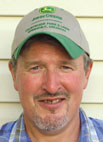
After 34 years of teaching, Bill Roberts hung up his hat and retired at the end of the 2010 school year. He spent the last 25 years teaching Agriculture Education at Marshfield High School.
From his 325-acre farm in Dallas County, near Elkland, Mo., Bill said if there was one thing he hoped the kids learned from him, it was “that to have success, you have to keep hammering at it every day.” He added, “I don’t believe in short cuts. I believe in hard work. It’s about a teacher teaching every day and a student getting their lesson every day.” Bill’s students got their lessons, and it was evident through awards won at state and national levels.
Although Bill has no cattle of his own, 210 Holstein heifers graze on his farm. He said, “I custom graze them for someone else.” That is where Bill’s farming knowledge comes into play – he does intensive grazing.
“To me, what you’re trying to do is maximize the catching of solar energy,” he said. “The animal consumes grass, that energy from the sun floats through the grass, through the animal and to humans.”
Bill called intensive grazing “a biological process.” He explained, “I don’t put on fertilizer. That, to me, is a chemical process. When you use pesticides, that is a chemical process. Since World War II, 1945, that’s what we’ve done. Natural gas is the precursor of nitrogen fertilizer, so after that, we were making gun powder. We turned those plants into nitrogen fertilizer plants. Grow a big flush of it, bale it up into round bales, put it in the silo and feed it back the rest of the year. The trouble with that system now is capital costs are very high; land and machinery.”
Bill strives to “be sustainable; not put on fertilizer. I haven’t in 10 or 12 years, other than a little bit here or there for different reasons.”
To make his system work, Bill said, “I put a lot of animals on a small space for a very short time – intensive grazing.” Right now his intensity is about 100 head of cattle on two and a half acres for 24 hours. Bill stated, “Before I retired, I was moving them every other day and it was a little bigger plot of ground.”
By grazing the cattle on a small plot for a short time, the cattle graze on the high nutritional forages. To put it in human terms, they get their chocolate cake, but eat their vegetables.
Utilizing warm-season grasses is something Bill does very well but said it’s tricky. “They’re hard to get to germinate and grow. You might do everything wrong and have the perfect stand. You might do everything right and nothing seems to work.”
Bill said he works to get the soil and grazing right, and then lets the native grasses grow. “What I try to do is enhance Mother Nature,” Bill explained. “Warm season grasses fill in the summertime lull. They have a short growing season, but if you get some rain, they make a lot of growth in a short period of time.”
As for the future, Bill has a few ideas about things to add to the farm income, and wants to learn more about intensive grazing. Now that he’s retired, he plans to “do whatever hits my fancy.”







